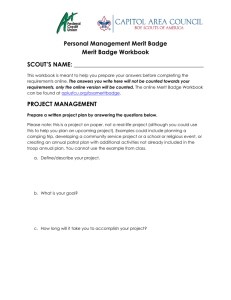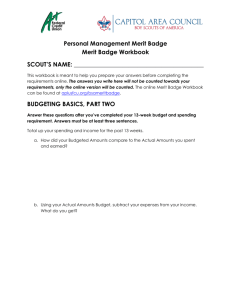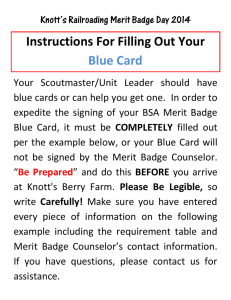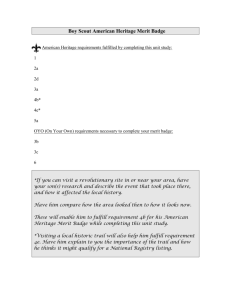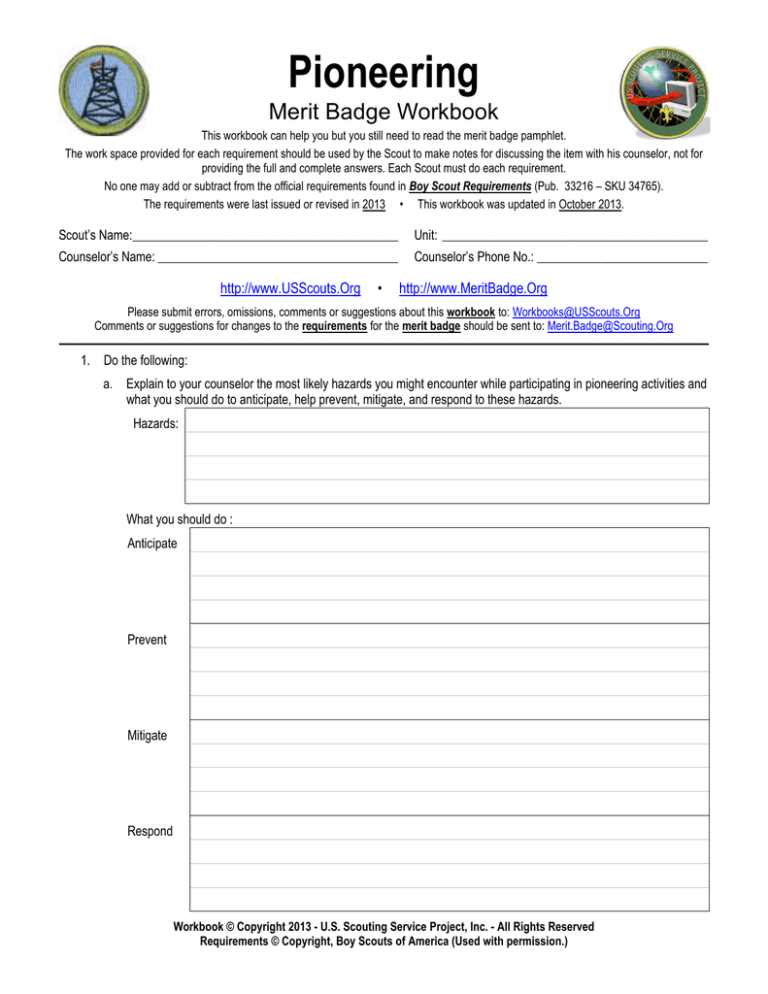
Pioneering
Merit Badge Workbook
This workbook can help you but you still need to read the merit badge pamphlet.
The work space provided for each requirement should be used by the Scout to make notes for discussing the item with his counselor, not for
providing the full and complete answers. Each Scout must do each requirement.
No one may add or subtract from the official requirements found in Boy Scout Requirements (Pub. 33216 – SKU 34765).
The requirements were last issued or revised in 2013 • This workbook was updated in October 2013.
Scout’s Name:__________________________________________
Unit: __________________________________________
Counselor’s Name: ______________________________________
Counselor’s Phone No.: ___________________________
http://www.USScouts.Org
•
http://www.MeritBadge.Org
Please submit errors, omissions, comments or suggestions about this workbook to: Workbooks@USScouts.Org
Comments or suggestions for changes to the requirements for the merit badge should be sent to: Merit.Badge@Scouting.Org
______________________________________________________________________________________________________________________________________________
1. Do the following:
a. Explain to your counselor the most likely hazards you might encounter while participating in pioneering activities and
what you should do to anticipate, help prevent, mitigate, and respond to these hazards.
Hazards:
What you should do :
Anticipate
Prevent
Mitigate
Respond
Workbook © Copyright 2013 - U.S. Scouting Service Project, Inc. - All Rights Reserved
Requirements © Copyright, Boy Scouts of America (Used with permission.)
Pioneering
Scout's Name: ________________________
b. Discuss the prevention of, and first aid treatment for, injuries and conditions that could occur while working on
pioneering projects, including cuts, scratches, insect bites and stings, rope burns, hypothermia, dehydration, heat
exhaustion, heatstroke, sunburn, and falls.
Cuts:
Scratches:
Insect bites
and stings:
Rope burns:
Hypothermia:
Dehydration:
Heat
Exhaustion:
Heat Stroke:
Sunburn:
Falls:
Pioneering - Merit Badge Workbook
Page. 2 of 11
Pioneering
Scout's Name: ________________________
2. Do the following:
a. Successfully complete Tenderfoot requirements 4a and 4b and First Class requirements 7a, 7b, and 7c. (These are
the rope-related requirements.)
Tenderfoot requirements 4a and 4b
4a. Demonstrate how to whip and fuse the ends of a rope.
4b. Demonstrate that you know how to tie the following knots and tell what their uses are: two half hitches and
the taut-line hitch
two half hitches
taut-line hitch
First Class requirements 7a, 7b, and 8a
7a. Discuss when you should and should not use lashings.
Then demonstrate tying the timber hitch and clove hitch and their use in square, shear, and diagonal
lashings by joining two or more poles or staves together.
7b. Use lashing to make a useful camp gadget.
8a. Demonstrate tying the bowline knot and describe several ways it can be used.
Pioneering - Merit Badge Workbook
Page. 3 of 11
Pioneering
Scout's Name: ________________________
b. Tie the following: square knot, bowline, sheepshank, sheet bend, and roundturn with two half hitches.
Square knot
Bowline
Sheepshank
Sheet bend
Roundturn with two half hitches
c. Demonstrate the following: tripod and round lashings.
Tripod lashing
Round lashing
3. Explain why it is useful to be able to throw a rope, then demonstrate how to coil and throw a 40-foot length of 1/4- or 3/8inch rope.
Demonstrate how to coil and throw a 40-foot length of 1/4- or 3/8-inch rope
Explain how to improve your throwing distance by adding weight to the end of your rope.
4. Explain the differences between synthetic ropes and natural-fiber ropes.
Synthetic ropes
Pioneering - Merit Badge Workbook
Page. 4 of 11
Pioneering
Scout's Name: ________________________
Natural-fiber
ropes
Discuss which types of rope are suitable for pioneering work and why. Include the following in your discussion: breaking
strength, safe working loads, and the care and storage of rope.
Type of rope:
Why suitable:
Breaking strength
Safe working loads
Care & storage
Type of rope:
Why suitable:
Breaking strength
Safe working loads
Care & storage
Pioneering - Merit Badge Workbook
Page. 5 of 11
Pioneering
Scout's Name: ________________________
Type of rope:
Why suitable:
Breaking strength
Safe working loads
Care & storage
Type of rope:
Why suitable:
Breaking strength
Safe working loads
Care & storage
Type of rope:
Why suitable:
Breaking strength
Safe working loads
Care & storage
Pioneering - Merit Badge Workbook
Page. 6 of 11
Pioneering
Scout's Name: ________________________
5. Explain the uses for the back splice, eye splice, and short splice.
Back splice:
Eye splice:
Short splice:
Using 1/4- or 3/8-inch three-stranded rope, demonstrate how to form each splice.
Back splice
Eye splice
Short splice
6. Using a rope-making device or machine, make a rope at least 6 feet long consisting of three strands, each having three
yarns.
7. Build a scale model of a signal tower or a monkey bridge. Correctly anchor the model using either the 1-1-1 anchoring
system or the log and stake anchoring method. Describe the design of your project and explain how the anchoring
system works.
Pioneering - Merit Badge Workbook
Page. 7 of 11
Pioneering
Scout's Name: ________________________
8. Demonstrate the use of rope tackle to lift a weight of 25 pounds and pulling a log at least 6 inches in diameter and 6 feet
long with the tackle. Use the tackle to put tension on a line.
Explain the advantages, disadvantages, and limitations of using a rope tackle.
Advantages:
Disadvantages:
Limitations:
In your explanation, describe the potential damage that friction can do to a rope.
9. By yourself, build an A -trestle OR X-trestle OR H -trestle using square and diagonal lashings.
Explain the application of the trestle you build.
Demonstrate how to tie two spars together using a shear lashing.
Pioneering - Merit Badge Workbook
Page. 8 of 11
Pioneering
Scout's Name: ________________________
10. With a group of Scouts, OR on your own, select a pioneering project and get your counselor’s approval before you begin
building. Your project must not result in anyone reaching a height of greater than 6 feet off the ground. With your
counselor's guidance, create a rough sketch of the project. Make a list of the ropes and spars needed, then build the
project. (Note: This requirement may be done at summer camp, at district or council events, or on a troop camp outing.)
Project selected:
Counselor’s approval:
Date:
Create a rough sketch of the project
Pioneering - Merit Badge Workbook
Page. 9 of 11
Pioneering
Scout's Name: ________________________
Make a list of the ropes and spars needed
Ropes
Number
Length
Spars
Diameter
Number
Length
Build the project
Requirement resources can be found here:
http://www.meritbadge.org/wiki/index.php/Pioneering#Requirement resources
Pioneering - Merit Badge Workbook
Page. 10 of 11
Important excerpts from the Guide To Advancement - 2013, No. 33088 (SKU-618673)
[1.0.0.0] — Introduction
The current edition of the Guide to Advancement is the official source for administering advancement in all Boy Scouts of America programs: Cub
Scouting, Boy Scouting, Varsity Scouting, Venturing, and Sea Scouts. It replaces any previous BSA advancement manuals, including Advancement
Committee Policies and Procedures, Advancement and Recognition Policies and Procedures, and previous editions of the Guide to Advancement.
[Page 2, and 5.0.1.4] — Policy on Unauthorized Changes to Advancement Program
No council, committee, district, unit, or individual has the authority to add to, or subtract from, advancement requirements. There are limited
exceptions relating only to youth members with special needs. For details see section 10, “Advancement for Members With Special Needs”.
[Page 2] — The “Guide to Safe Scouting” Applies
Policies and procedures outlined in the Guide to Safe Scouting, No. 34416, apply to all BSA activities, including those related to advancement and
Eagle Scout service projects.
[7.0.3.1] — The Buddy System and Certifying Completion
A youth member must not meet one-on-one with an adult. Sessions with counselors must take place where others can view the interaction, or the
Scout must have a buddy: a friend, parent, guardian, brother, sister, or other relative— or better yet, another Scout working on the same badge— along
with him attending the session.
When the Scout meets with the counselor, he should bring any required projects. If these cannot be transported, he should present evidence, such as
photographs or adult verification. His unit leader, for example, might state that a satisfactory bridge or tower has been built for the Pioneering merit
badge, or that meals were prepared for Cooking. If there are questions that requirements were met, a counselor may confirm with adults involved.
Once satisfied, the counselor signs the blue card using the date upon which the Scout completed the requirements, or in the case of partials, initials
the individual requirements passed.
Note that from time to time, it may be appropriate for a requirement that has been met for one badge to also count for another. See “Fulfilling More
Than One Requirement With a Single Activity,” 4.2.3.6.
[7.0.3.2] — Group Instruction
It is acceptable— and sometimes desirable— for merit badges to be taught in group settings. This often occurs at camp and merit badge midways or
similar events. Interactive group discussions can support learning. The method can also be attractive to “guest experts” assisting registered and
approved counselors. Slide shows, skits, demonstrations, panels, and various other techniques can also be employed, but as any teacher can attest,
not everyone will learn all the material.
There must be attention to each individual’s projects and his fulfillment of all requirements. We must know that every Scout — actually and
personally— completed them. If, for example, a requirement uses words like “show,” “demonstrate,” or “discuss,” then every Scout must do that. It is
unacceptable to award badges on the basis of sitting in classrooms watching demonstrations, or remaining silent during discussions.
It is sometimes reported that Scouts who have received merit badges through group instructional settings have not fulfilled all the requirements. To
offer a quality merit badge program, council and district advancement committees should ensure the following are in place for all group instructional
events.
Merit badge counselors are known to be registered and approved.
Any guest experts or guest speakers, or others assisting who are not registered and approved as merit badge counselors, do not accept the
responsibilities of, or behave as, merit badge counselors, either at a group instructional event or at any other time. Their service is temporary, not
ongoing.
Counselors agree not to assume prerequisites have been completed without some level of evidence that the work has been done. Pictures and
letters from other merit badge counselors or unit leaders are the best form of prerequisite documentation when the actual work done cannot be
brought to the camp or site of the merit badge event.
There is a mechanism for unit leaders or others to report concerns to a council advancement committee on summer camp merit badge programs,
group instructional events, and any other merit badge counseling issues— especially in instances where it is believed BSA procedures are not
followed. See “Reporting Merit Badge Counseling Concerns,” 11.1.0.0.
There must be attention to each individual’s projects and his fulfillment of all requirements. We must know that every Scout— actually and
personally— completed them.
[7.0.3.3] — Partial Completions
A Scout need not pass all the requirements of one merit badge with the same counselor. It may be that due to timing or location issues, etc., he must
meet with a different counselor to finish the badge. The Application for Merit Badge has a place to record what has been finished— a “partial.” In the
center section on the reverse of the blue card, the counselor initials for each requirement passed. In the case of a partial completion, the counselor
does not retain his or her portion of the card. A subsequent counselor may choose not to accept partial work, but this should be rare. A Scout, if he
believes he is being treated unfairly, may work with his unit leader to find another counselor. An example for the use of a signed partial would be to
take it to camp as proof of prerequisites. Partials have no expiration except the Scout’s 18th birthday. Units, districts, or councils shall not establish
other expiration dates for partial merit badges.
[7.0.4.8] — Unofficial Worksheets and Learning Aids
Worksheets and other materials that may be of assistance in earning merit badges are available from a variety of places including unofficial sources
on the Internet and even troop libraries. Use of these aids is permissible as long as the materials can be correlated with the current requirements that
Scouts must fulfill. Completing “worksheets” may suffice where a requirement calls for something in writing, but this would not work for a requirement
where the Scout must discuss, tell, show, or demonstrate, etc. Note that Scouts shall not be required to use these learning aids in order to complete a
merit badge.
Attachment
(NOTE: It is not necessary to print this page.)
Page 11 of 11

